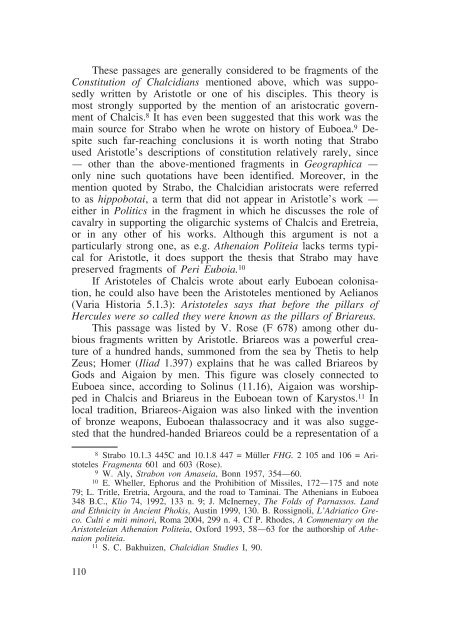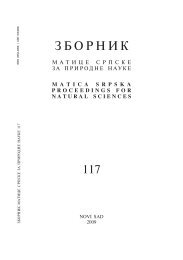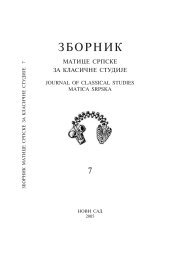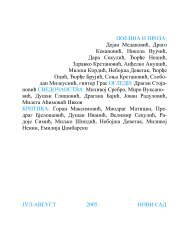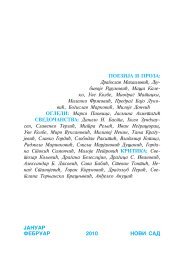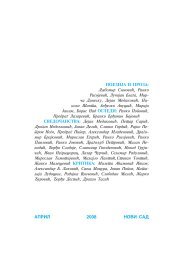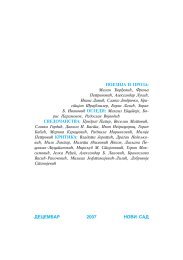You also want an ePaper? Increase the reach of your titles
YUMPU automatically turns print PDFs into web optimized ePapers that Google loves.
These passages are generally considered to be fragments of the<br />
Constitution of Chalcidians mentioned above, which was supposedly<br />
written by Aristotle or one of his disciples. This theory is<br />
most strongly supported by the mention of an aristocratic government<br />
of Chalcis. 8 It has even been suggested that this work was the<br />
main source for Strabo when he wrote on history of Euboea. 9 Despite<br />
such far-reaching conclusions it is worth noting that Strabo<br />
used Aristotle's descriptions of constitution relatively rarely, since<br />
— other than the above-mentioned fragments in Geographica —<br />
only nine such quotations have been identified. Moreover, in the<br />
mention quoted by Strabo, the Chalcidian aristocrats were referred<br />
to as hippobotai, a term that did not appear in Aristotle's work —<br />
either in Politics in the fragment in which he discusses the role of<br />
cavalry in supporting the oligarchic systems of Chalcis and Eretreia,<br />
or in any other of his works. Although this argument is not a<br />
particularly strong one, as e.g. Athenaion Politeia lacks terms typical<br />
for Aristotle, it does support the thesis that Strabo may have<br />
preserved fragments of Peri Euboia. 10<br />
If Aristoteles of Chalcis wrote about early Euboean colonisation,<br />
he could also have been the Aristoteles mentioned by Aelianos<br />
(Varia Historia 5.1.3): Aristoteles says that before the pillars of<br />
Hercules were so called they were known as the pillars of Briareus.<br />
This passage was listed by V. Rose (F 678) among other dubious<br />
fragments written by Aristotle. Briareos was a powerful creature<br />
of a hundred hands, summoned from the sea by Thetis to help<br />
Zeus; Homer (Iliad 1.397) explains that he was called Briareos by<br />
Gods and Aigaion by men. This figure was closely connected to<br />
Euboea since, according to Solinus (11.16), Aigaion was worshipped<br />
in Chalcis and Briareus in the Euboean town of Karystos. 11 In<br />
local tradition, Briareos-Aigaion was also linked with the invention<br />
of bronze weapons, Euboean thalassocracy and it was also suggested<br />
that the hundred-handed Briareos could be a representation of a<br />
8 Strabo 10.1.3 445C and 10.1.8 447 = Müller FHG. 2 105 and 106 = Aristoteles<br />
Fragmenta 601 and 603 (Rose).<br />
9 W. Aly, Strabon von Amaseia, Bonn 1957, 354—60.<br />
10 E. Wheller, Ephorus and the Prohibition of Missiles, 172—175 and note<br />
79; L. Tritle, Eretria, Argoura, and the road to Taminai. The Athenians in Euboea<br />
348 B.C., Klio 74, 1992, 133 n. 9; J. McInerney, The Folds of Parnassos. Land<br />
and Ethnicity in Ancient Phokis, Austin 1999, 130. B. Rossignoli, L'Adriatico Greco.<br />
Culti e miti minori, Roma 2004, 299 n. 4. Cf P. Rhodes, A Commentary on the<br />
Aristoteleian Athenaion Politeia, Oxford 1993, 58—63 for the authorship of Athenaion<br />
politeia.<br />
11 S. C. Bakhuizen, Chalcidian Studies I, 90.<br />
110


